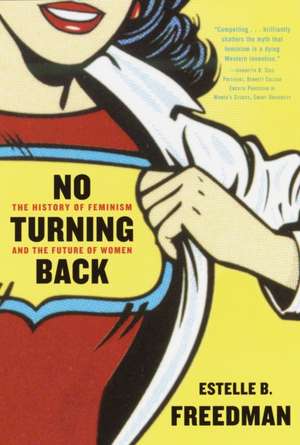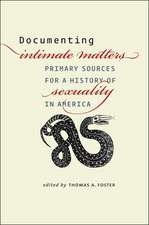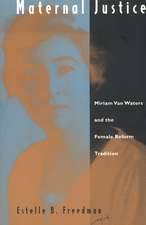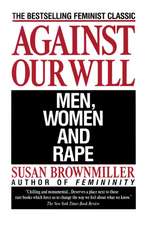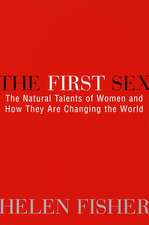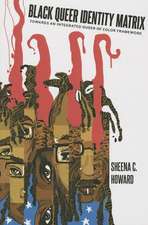No Turning Back: The History of Feminism and the Future of Women
Autor Estelle B. Freedmanen Limba Engleză Paperback – 31 dec 2002
–NANCY F. COTT
Professor of History, Harvard University
Repeatedly declared dead by the media, the women’s movement has never been as vibrant as it is today. Indeed as Stanford professor and award-winning author Estelle B. Freedman argues in her compelling book, feminism has reached a critical momentum from which there is no turning back. Freedman examines the historical forces that have fueled the feminist movement over the past two hundred years–and explores how women today are looking to feminism for new approaches to issues of work, family, sexuality, and creativity.
Drawing examples from a variety of countries and cultures, from the past and the present, this inspiring narrative will be required reading for anyone who wishes to understand the role women play in the world. Searching in its analysis and global in its perspective, No Turning Back will stand as a defining text in one of the most important social movements of all time.
Preț: 118.10 lei
Nou
Puncte Express: 177
Preț estimativ în valută:
22.60€ • 23.51$ • 18.66£
22.60€ • 23.51$ • 18.66£
Carte disponibilă
Livrare economică 24 martie-07 aprilie
Preluare comenzi: 021 569.72.76
Specificații
ISBN-13: 9780345450531
ISBN-10: 0345450531
Pagini: 464
Dimensiuni: 140 x 209 x 25 mm
Greutate: 0.37 kg
Editura: BALLANTINE BOOKS
ISBN-10: 0345450531
Pagini: 464
Dimensiuni: 140 x 209 x 25 mm
Greutate: 0.37 kg
Editura: BALLANTINE BOOKS
Notă biografică
For the past twenty-five years, Estelle B. Freedman, a founder of the Program in Feminist Studies at Stanford University, has written about the history of women in the United States. Freedman is the author of two award-winning studies: Their Sisters’ Keepers: Women’s Prison Reform in America, 1830-1930 and Maternal Justice: Miriam Van Waters and the Female Reform Tradition. Freedman coauthored Intimate Matters: A History of Sexuality in America, which was a New York Times Notable Book. Professor Freedman lives in San Francisco.
From the Hardcover edition.
From the Hardcover edition.
Extras
THE HISTORICAL CASE FOR FEMINISM
In the past two centuries, a revolution has transformed women’s lives. Unlike national revolutions, this social upheaval crosses continents, decades, and ideologies. In place of armed struggle it gradually sows seeds of change, infiltrating our consciousness with the simple premise that women are as capable and valuable as men. To measure the breadth of this ongoing upheaval of old patterns, consider the way feminist movements have transformed law and politics, from divorce reforms in Egypt and sexual harassment cases in Japan and the United States to the nomination of equal numbers of male and female candidates by French political parties. Or note the change in leadership: During the 1990s, 90 percent of the world’s nations elected women to national office, and women served as heads of state in more than twenty countries. Just as important, consider the thousands of grassroots organizations such as Women in Law and Development in Africa, the National Black Women’s Health Project in the United States, and the Self-Employed Women’s Association in India. Women’s movements have never been so widespread.
In No Turning Back I explain why and how a feminist revolution has occurred. I argue that two related historical transitions have propelled feminist politics. First, the rise of capitalism disrupted older, reciprocal relations within families in ways that initially enhanced men’s economic opportunities and defined women as their dependents. Second, new political theories of individual rights and representative government that developed alongside capitalism extended privileges to men only. In response, feminist movements named these disparities as unjust, insisting on the value of women’s economic contributions and the justice of political rights for women. In short, the market economies and democratic systems that now dominate the world create both the need for feminism and the means to sustain it.
Feminist politics originated where capitalism, industrial growth, democratic theory, and socialist critiques converged, as they did in Europe and North America after 1800. Women and their male allies began to agitate for equal educational, economic, and political opportunities, a struggle that continues to the present. By 1900 an international women’s movement advanced these goals in urban areas of Latin America, the Middle East, and Asia. Since 1970 feminism has spread globally, in both industrialized nations and in the developing regions where agriculture remains an economic mainstay.
Given their specific historical origins, the feminist politics initially forged in Europe and North America have not simply expanded throughout the world. Elsewhere, abundant forms of women’s resistance to men’s patriarchal authority predated Western democratic theories; they continue to influence feminist movements today. Socialist responses to capitalism invite quite different women’s politics than where free markets prevail. Both the term feminism and the politics it represents have been continually transformed by the evolving responses of women and men from a variety of cultures. Indeed, women’s politics have developed organically in settings so diverse that the plural feminisms more accurately describes them.
By the year 2000 these growing international movements to improve women’s lives increasingly influenced each other, due in part to the forum provided by the United Nations Decade for Women from 1975 to 1985 and the follow-up conference in Beijing in 1995. While they share the conviction that women deserve full human rights, international feminisms often diverge in their emphases. Only some concentrate solely on women, while others recognize complex links to the politics of race, class, religion, and nationality. Despite these differences, most Western feminists have learned that global economic and political justice are prerequisites to securing women’s rights. Women in the developing world have found that transnational feminist movements can help establish strategic international support for their efforts at home.
None of these feminist movements has proceeded without opposition, including formidable backlash in every era in which women have gained public authority. Nonetheless, at the beginning of the twenty-first century the historical conditions that promote feminism can be found in much of the world. Whether through the influence of Western economic and political systems, the refashioning of earlier practices, or both, an impressive array of movements now attempts to empower women. At present, economic globalization, along with international efforts to create stable democratic governments, suggests that new forms of feminism will continue to surface. Because of their flexibility and adaptability, women’s political movements, whether explicitly labeled feminist or not, have set much of the world’s agenda for the twenty-first century.
THE HISTORY OF A TERM
Since I use feminism to describe movements whose participants do not necessarily apply that label themselves, I want to acknowledge at the outset the specific historical origins of this term. Feminism is a relatively recent word. First coined in France in the 1880s as féminisme, it spread through European countries in the 1890s and to North and South America by 1910. The term combined the French word for woman, femme, and -isme, which referred to a social movement or political ideology. At a time when many other “isms” originated, including socialism and communism, féminisme connoted that women’s issues belonged to the vanguard of change. The term was always controversial, in part because of its association with radicalism and in part because proponents themselves disagreed about the label. Although self-defined socialist feminists appeared in Europe as early as 1900, many socialists who supported women’s emancipation rejected the label feminist. They believed that middle-class demands for suffrage and property rights did not necessarily speak to working women’s needs for a living wage and job security. Middle-class women also hesitated to call themselves feminists, especially when the term implied a claim to universal rights as citizens rather than particular rights as mothers.
In the United States this conflict over the political meaning of feminism split the women’s movement for almost half a century. In the 1800s the usual label for first-wave activism was simply “the woman movement.” Along with educational and property rights, many of its participants linked authority for women to motherhood. After 1910, however, a younger generation consciously rejected the maternal argument in favor of women’s common human identity with men as a basis for equal rights. They claimed a feminist political identity and staged dramatic public protests during the suffrage movement. After U.S. women won the vote in 1920, the feminists single-minded campaign to pass an equal-rights amendment to the U.S. Constitution further cemented the association of feminism, extremism, and a rejection of the concept of female difference. For decades, most women social reformers opposed the amendment and rejected the feminist label.
From its origins through the social upheavals of the 1960s, feminist remained a pejorative term among most progressive reformers, suffragists, and socialists around the world. Even as universal adult suffrage gradually extended to women—in England in 1928, in countries such as France, Japan, Mexico, and China by the late 1940s—few politically engaged women called themselves feminists. Within the international women’s movement, participants debated whether the term humanist rather than feminist best applied to them. Nations ruled by communist parties, such as China and later Cuba, officially pronounced the emancipation of women as workers, but their state-sanctioned women’s organizations rejected the feminist label and their suppression of oppositional political discourse precluded feminist politics.
A critical turning point in the history of feminisms occurred during the politically tumultuous 1960s. Women’s politics revived in the West, at first under the banner of “women’s liberation.” Although the press quickly derided adherents by calling them “women’s libbers,” this second wave proved quite tenacious. By this time, both capitalist and socialist economies had drawn millions of women into the paid labor force, and civil rights and anticolonial movements had revived the politics of democratization. In Europe and the United States, millions of women expected to earn wages as well as raise children. The old feminist calls for economic and political equality, and a new emphasis on control over reproduction, resonated deeply across generations, classes, and races.
Western women’s movements also significantly expanded their agendas after the 1960s. Along with demands for economic and political rights, women’s liberation revived a politics of difference through its critique of interpersonal relations. Women’s liberation championed both women’s equality with men in work and politics and women’s difference from men within the arenas of reproduction and sexuality. In this way the two competing strains of equality and difference began to converge. Within a decade, the older term feminist began to be used to refer to the politics of this new movement, deepening its radical connotation but potentially widening its appeal. At about the same time, the introduction of the term gender, rather than sex, signaled feminists’ growing belief that social practices, and not only biology, have constructed our notions of male and female.
By 1980 an umbrella usage of the term feminism took hold in Western cultures. Anyone who challenged prevailing gender relations might now be called a feminist, whether or not they lived long before the coining of the term feminism, agreed with all the tenets of women’s liberation, or claimed the label. A generation of Western women came of age influenced by feminism to expect equal opportunities. The majority of this generation often proclaimed, “I’m not a feminist, but . . . ,” even as they insisted on equal pay, sexual and reproductive choice, parental leave, and political representation. The children they raised, both male and female, grew up influenced by these feminist expectations but not necessarily comfortable with the term. Outside the West, the term feminism could still evoke a narrow focus on equal rights. Thus a 1991 essay in the influential Indian women’s journal Manushi, titled “Why I Do Not Call Myself a Feminist,” contrasted Western concerns about women’s rights with broader human rights and social justice campaigns that address the needs of both men and women in developing countries.1
The term feminism, in short, has never been widely popular. Yet the political goals of feminism have survived—despite continuing dis- comfort with the term, a hostile political climate, and heated internal criticism—largely because feminism has continually redefined itself.
Over the past twenty-five years, for example, activists have amended the term to make it more compatible with their unique perspectives. Self-naming by black feminists, Asian American feminists, Third World feminists, lesbian feminists, male feminists, ecofeminists, Christian feminists, Jewish feminists, Islamic feminists, and others attests to the malleability of the label and to the seemingly contradictory politics it can embrace. To make the movement more racially inclusive, the African American writer Alice Walker once coined womanist to refer to a “Black feminist or feminist of color.” In the 1990s young women in the United States such as Walker’s daughter promised to go beyond the second wave of feminism by forging a more racially and sexually diverse movement that emphasized female empowerment rather than male oppression. “I’m not post-feminist,” Rebecca Walker explained in 1992, “I’m the Third Wave.”2 Significantly, this generation reclaims rather than rejects the term feminist. Internationally as well, more women’s organizations incorporate the word, such as the Feminist League in Central Asia, the Center for Feminist Legal Research in New Delhi, and the Working Group Toward a Feminist Europe.
By the 1990s the cumulative contributions of working-class women, lesbians, women of color, and activists from the developing world had transformed an initially white, European, middle-class politics into a more diverse and mature feminist movement. Taking into account the range of women’s experiences, feminists have increasingly recognized the validity of arguments that once seemed contradictory. Instead of debating whether women are similar to or different from men, most feminists now recognize that both statements are true. Instead of asking which is more important, gender or race, most feminists now acknowledge the indivisibility and interaction of these social categories. Along with demanding the right to work, feminists have redefined work to include caring as well as earning. Along with calling for women’s independence, feminists have recognized the interdependence of all people, as well as the interconnection of gender equality with broader social justice movements.
From the Hardcover edition.
In the past two centuries, a revolution has transformed women’s lives. Unlike national revolutions, this social upheaval crosses continents, decades, and ideologies. In place of armed struggle it gradually sows seeds of change, infiltrating our consciousness with the simple premise that women are as capable and valuable as men. To measure the breadth of this ongoing upheaval of old patterns, consider the way feminist movements have transformed law and politics, from divorce reforms in Egypt and sexual harassment cases in Japan and the United States to the nomination of equal numbers of male and female candidates by French political parties. Or note the change in leadership: During the 1990s, 90 percent of the world’s nations elected women to national office, and women served as heads of state in more than twenty countries. Just as important, consider the thousands of grassroots organizations such as Women in Law and Development in Africa, the National Black Women’s Health Project in the United States, and the Self-Employed Women’s Association in India. Women’s movements have never been so widespread.
In No Turning Back I explain why and how a feminist revolution has occurred. I argue that two related historical transitions have propelled feminist politics. First, the rise of capitalism disrupted older, reciprocal relations within families in ways that initially enhanced men’s economic opportunities and defined women as their dependents. Second, new political theories of individual rights and representative government that developed alongside capitalism extended privileges to men only. In response, feminist movements named these disparities as unjust, insisting on the value of women’s economic contributions and the justice of political rights for women. In short, the market economies and democratic systems that now dominate the world create both the need for feminism and the means to sustain it.
Feminist politics originated where capitalism, industrial growth, democratic theory, and socialist critiques converged, as they did in Europe and North America after 1800. Women and their male allies began to agitate for equal educational, economic, and political opportunities, a struggle that continues to the present. By 1900 an international women’s movement advanced these goals in urban areas of Latin America, the Middle East, and Asia. Since 1970 feminism has spread globally, in both industrialized nations and in the developing regions where agriculture remains an economic mainstay.
Given their specific historical origins, the feminist politics initially forged in Europe and North America have not simply expanded throughout the world. Elsewhere, abundant forms of women’s resistance to men’s patriarchal authority predated Western democratic theories; they continue to influence feminist movements today. Socialist responses to capitalism invite quite different women’s politics than where free markets prevail. Both the term feminism and the politics it represents have been continually transformed by the evolving responses of women and men from a variety of cultures. Indeed, women’s politics have developed organically in settings so diverse that the plural feminisms more accurately describes them.
By the year 2000 these growing international movements to improve women’s lives increasingly influenced each other, due in part to the forum provided by the United Nations Decade for Women from 1975 to 1985 and the follow-up conference in Beijing in 1995. While they share the conviction that women deserve full human rights, international feminisms often diverge in their emphases. Only some concentrate solely on women, while others recognize complex links to the politics of race, class, religion, and nationality. Despite these differences, most Western feminists have learned that global economic and political justice are prerequisites to securing women’s rights. Women in the developing world have found that transnational feminist movements can help establish strategic international support for their efforts at home.
None of these feminist movements has proceeded without opposition, including formidable backlash in every era in which women have gained public authority. Nonetheless, at the beginning of the twenty-first century the historical conditions that promote feminism can be found in much of the world. Whether through the influence of Western economic and political systems, the refashioning of earlier practices, or both, an impressive array of movements now attempts to empower women. At present, economic globalization, along with international efforts to create stable democratic governments, suggests that new forms of feminism will continue to surface. Because of their flexibility and adaptability, women’s political movements, whether explicitly labeled feminist or not, have set much of the world’s agenda for the twenty-first century.
THE HISTORY OF A TERM
Since I use feminism to describe movements whose participants do not necessarily apply that label themselves, I want to acknowledge at the outset the specific historical origins of this term. Feminism is a relatively recent word. First coined in France in the 1880s as féminisme, it spread through European countries in the 1890s and to North and South America by 1910. The term combined the French word for woman, femme, and -isme, which referred to a social movement or political ideology. At a time when many other “isms” originated, including socialism and communism, féminisme connoted that women’s issues belonged to the vanguard of change. The term was always controversial, in part because of its association with radicalism and in part because proponents themselves disagreed about the label. Although self-defined socialist feminists appeared in Europe as early as 1900, many socialists who supported women’s emancipation rejected the label feminist. They believed that middle-class demands for suffrage and property rights did not necessarily speak to working women’s needs for a living wage and job security. Middle-class women also hesitated to call themselves feminists, especially when the term implied a claim to universal rights as citizens rather than particular rights as mothers.
In the United States this conflict over the political meaning of feminism split the women’s movement for almost half a century. In the 1800s the usual label for first-wave activism was simply “the woman movement.” Along with educational and property rights, many of its participants linked authority for women to motherhood. After 1910, however, a younger generation consciously rejected the maternal argument in favor of women’s common human identity with men as a basis for equal rights. They claimed a feminist political identity and staged dramatic public protests during the suffrage movement. After U.S. women won the vote in 1920, the feminists single-minded campaign to pass an equal-rights amendment to the U.S. Constitution further cemented the association of feminism, extremism, and a rejection of the concept of female difference. For decades, most women social reformers opposed the amendment and rejected the feminist label.
From its origins through the social upheavals of the 1960s, feminist remained a pejorative term among most progressive reformers, suffragists, and socialists around the world. Even as universal adult suffrage gradually extended to women—in England in 1928, in countries such as France, Japan, Mexico, and China by the late 1940s—few politically engaged women called themselves feminists. Within the international women’s movement, participants debated whether the term humanist rather than feminist best applied to them. Nations ruled by communist parties, such as China and later Cuba, officially pronounced the emancipation of women as workers, but their state-sanctioned women’s organizations rejected the feminist label and their suppression of oppositional political discourse precluded feminist politics.
A critical turning point in the history of feminisms occurred during the politically tumultuous 1960s. Women’s politics revived in the West, at first under the banner of “women’s liberation.” Although the press quickly derided adherents by calling them “women’s libbers,” this second wave proved quite tenacious. By this time, both capitalist and socialist economies had drawn millions of women into the paid labor force, and civil rights and anticolonial movements had revived the politics of democratization. In Europe and the United States, millions of women expected to earn wages as well as raise children. The old feminist calls for economic and political equality, and a new emphasis on control over reproduction, resonated deeply across generations, classes, and races.
Western women’s movements also significantly expanded their agendas after the 1960s. Along with demands for economic and political rights, women’s liberation revived a politics of difference through its critique of interpersonal relations. Women’s liberation championed both women’s equality with men in work and politics and women’s difference from men within the arenas of reproduction and sexuality. In this way the two competing strains of equality and difference began to converge. Within a decade, the older term feminist began to be used to refer to the politics of this new movement, deepening its radical connotation but potentially widening its appeal. At about the same time, the introduction of the term gender, rather than sex, signaled feminists’ growing belief that social practices, and not only biology, have constructed our notions of male and female.
By 1980 an umbrella usage of the term feminism took hold in Western cultures. Anyone who challenged prevailing gender relations might now be called a feminist, whether or not they lived long before the coining of the term feminism, agreed with all the tenets of women’s liberation, or claimed the label. A generation of Western women came of age influenced by feminism to expect equal opportunities. The majority of this generation often proclaimed, “I’m not a feminist, but . . . ,” even as they insisted on equal pay, sexual and reproductive choice, parental leave, and political representation. The children they raised, both male and female, grew up influenced by these feminist expectations but not necessarily comfortable with the term. Outside the West, the term feminism could still evoke a narrow focus on equal rights. Thus a 1991 essay in the influential Indian women’s journal Manushi, titled “Why I Do Not Call Myself a Feminist,” contrasted Western concerns about women’s rights with broader human rights and social justice campaigns that address the needs of both men and women in developing countries.1
The term feminism, in short, has never been widely popular. Yet the political goals of feminism have survived—despite continuing dis- comfort with the term, a hostile political climate, and heated internal criticism—largely because feminism has continually redefined itself.
Over the past twenty-five years, for example, activists have amended the term to make it more compatible with their unique perspectives. Self-naming by black feminists, Asian American feminists, Third World feminists, lesbian feminists, male feminists, ecofeminists, Christian feminists, Jewish feminists, Islamic feminists, and others attests to the malleability of the label and to the seemingly contradictory politics it can embrace. To make the movement more racially inclusive, the African American writer Alice Walker once coined womanist to refer to a “Black feminist or feminist of color.” In the 1990s young women in the United States such as Walker’s daughter promised to go beyond the second wave of feminism by forging a more racially and sexually diverse movement that emphasized female empowerment rather than male oppression. “I’m not post-feminist,” Rebecca Walker explained in 1992, “I’m the Third Wave.”2 Significantly, this generation reclaims rather than rejects the term feminist. Internationally as well, more women’s organizations incorporate the word, such as the Feminist League in Central Asia, the Center for Feminist Legal Research in New Delhi, and the Working Group Toward a Feminist Europe.
By the 1990s the cumulative contributions of working-class women, lesbians, women of color, and activists from the developing world had transformed an initially white, European, middle-class politics into a more diverse and mature feminist movement. Taking into account the range of women’s experiences, feminists have increasingly recognized the validity of arguments that once seemed contradictory. Instead of debating whether women are similar to or different from men, most feminists now recognize that both statements are true. Instead of asking which is more important, gender or race, most feminists now acknowledge the indivisibility and interaction of these social categories. Along with demanding the right to work, feminists have redefined work to include caring as well as earning. Along with calling for women’s independence, feminists have recognized the interdependence of all people, as well as the interconnection of gender equality with broader social justice movements.
From the Hardcover edition.
Recenzii
“AN ASTONISHING FEAT, a comprehensive synthesis of a sprawling and often contradictory body of thought and activism.”
–San Francisco Examiner
“A TOUR DE FORCE . . . THIS IS A VERY IMPORTANT BOOK.”
–CATHARINE R. STIMPSON
University Professor
Dean of the Graduate School of Arts and Science
New York University
–San Francisco Examiner
“A TOUR DE FORCE . . . THIS IS A VERY IMPORTANT BOOK.”
–CATHARINE R. STIMPSON
University Professor
Dean of the Graduate School of Arts and Science
New York University
Descriere
Drawing examples from a variety of countries and cultures, from the past as well as from the present, this inspiring narrative examines the historical forces that have fueled the feminist movement over the past 200 years.
